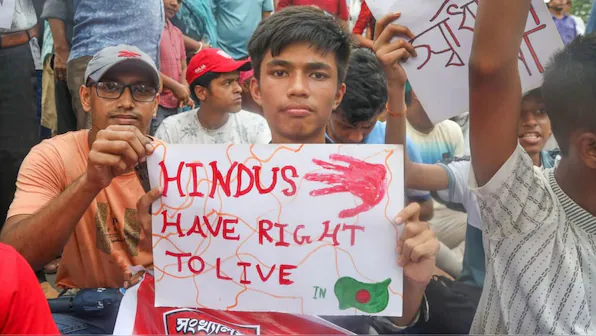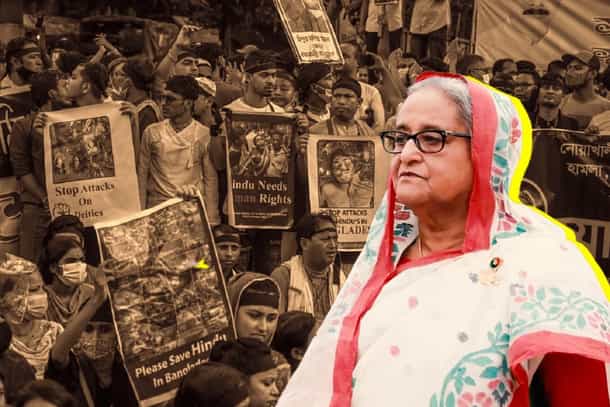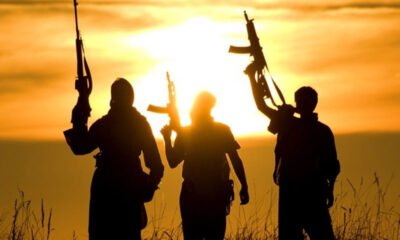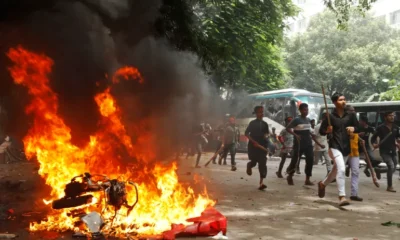Opinion
Did Bangladesh Just Put A Ban On Resident Hindus From Government Jobs? From Gandhi’s Failed Mission In Noakhali In 1946-47 To The Present, What Being A Hindu Means In Bangladesh?
Published
10 months agoon

The plight of Hindus in Bangladesh has once again come under scrutiny as the country struggles with a political and social crisis following the ouster of former Prime Minister Sheikh Hasina in August last year.
Through the ongoing political turmoil, the Hindu minority in Bangladesh has faced an alarming increase in atrocities, raising questions about their future in the Muslim-majority country.
Rising Violence Against Hindus
The period following Sheikh Hasina’s resignation has been marked by targeted violence against religious minorities, primarily Hindus. Between August 5 and 9, 2024, a report documented 190 cases of looting, 32 homes set ablaze, 16 temples desecrated, and two incidents of sexual violence.
By August 20, these numbers escalated significantly, with over 2,010 incidents of violence, including attacks on 157 families and the desecration of 69 temples. The violence has continued unabated despite the formation of an interim government under Muhammad Yunus on August 8, further alienating the Hindu community.
Systematic Discrimination in Employment
A recent development has yet again illustrated the marginalization of Hindus in Bangladesh.
This stance has manifested in a government order restricting the appointment of Hindus to police positions, ranging from constables to higher ranks. As a result, over 1,500 Hindu applicants were rejected, and 100 Hindu officers were dismissed, according to recent reports.

Historical and Political Context
Sheikh Hasina’s 15-year rule was perceived as relatively favorable for Bangladesh’s Hindu minority, which constitutes about 10% of the population. Her Awami League party was seen as a secular force that provided a degree of protection against the anti-Hindu rhetoric of opposition parties like the Bangladesh Nationalist Party (BNP) and Jamaat-e-Islami.
However, her abrupt departure led to widespread unrest, including large-scale looting, the ransacking of national monuments, and violent retribution against Awami League supporters and police officials.
The collapse of Hasina’s regime unleashed a wave of anti-Hindu sentiment, with groups that had been suppressed during her tenure gaining newfound strength.
According to the Bangladesh Hindu Buddhist Christian Unity Council (BHBCUC), there were 2,000 incidents of communal violence, including nine Hindu deaths and 69 attacks on places of worship, in the two weeks following Hasina’s resignation.
A Dual Burden of Persecution and Allegiance
For Bangladeshi Hindus, the attacks spotlight a painful reality – they are often forced to prove their loyalty to Bangladesh while navigating the stigma of being seen as sympathetic to India. Many Hindus, especially in rural areas, live in constant fear of violence and displacement. Lands have been forcibly seized, and justice or compensation remains elusive.
Yet here is some food for thought –
“India is home to 90% of our religious sites, and that’s where our connection lies,” said Pias, a 27-year-old Hindu student at Bangladesh University of Engineering and Technology. “However, the majority of Bangladeshi Hindus do not support the current Indian government or its ‘Hindutva’ extremism.”
This nuanced position shows the community’s precarious existence.
The pressure on Bangladeshi Hindus to dissociate from India becomes more complex when India is perceived as amplifying reports of atrocities against Hindus in Bangladesh, say community members.
“Hindus in Bangladesh are facing a twofold problem,” said Chakravarty, a 29-year-old pharmacy owner at Dowarabazar market, who spoke on condition of anonymity. “On one hand, Indian media spreads disinformation and exaggerates incidents, some of which never even happened. This fuels anti-India sentiment, which, in turn, contributes to a feeling of insecurity among us, the Hindus.”
Chakravarty himself narrowly survived an incident of violence indicating the growing insecurity among the Hindu community.
Who’s to Blame?
The interim leadership in Bangladesh, led by 84-year-old Nobel laureate Muhammad Yunus, has accused Indian media of exaggerating attacks on Hindus. Shafiqul Alam, press secretary to Yunus, acknowledged that some attacks on religious minorities occurred following the ousting of Sheikh Hasina.
However, he added, “Many of the events reported in the Indian media have been exaggerated and are part of an industrial-level dissemination of deliberate disinformation.”
The interim government claims to uphold “freedom of religion, freedom of association, and freedom of assembly for all religious institutions.” Yunus, calling for “national unity” among religious leaders last week, stated there is a “discrepancy between the reality and the news published by foreign media” regarding attacks on minorities.
Hindu Activism and Protests
Hindu activists have staged large-scale protests in Dhaka and other cities since August, demanding new laws to protect minorities, the establishment of a minority ministry, and a tribunal to prosecute acts of oppression. They also called for a five-day holiday for Durga Puja, the biggest festival for Hindu Bengalis.
Tensions escalated in November with the arrest of Chinmoy Krishna Das, a Hindu monk formerly associated with ISKCON. Das had been rallying protests after Hasina’s removal and was detained under a colonial-era sedition law after being accused of insulting the Bangladeshi flag by raising a saffron flag above it at a rally against violence targeting Hindus.
His arrest and subsequent bail denial sparked a wave of protests, culminating in a deadly clash with police. A Muslim lawyer was hacked to death outside a Chattogram court, allegedly by ISKCON supporters. The police arrested more than 20 individuals in connection with the murder. Lawyers and students have since called for a ban on ISKCON, but the Supreme Court has so far rejected petitions seeking such a ban.
Hasina’s Accusations
Sheikh Hasina, speaking from exile in India, accused Yunus of failing to protect Hindus and other minorities. “Hindus, Buddhists, Christians – no one has been spared. Eleven churches have been destroyed. Temples and Buddhist shrines have been broken. When the Hindus protested, the ISKCON leader was arrested,” Hasina said.
So here is the question – Were Hindus Safer During Hasina’s Regime?
Some members of the Hindu community argue that the perception of safety under Sheikh Hasina’s Awami League regime may have been more psychological than real.
Bhattacharjee, a Hindu landowner, recalls losing two acres of family land to activists associated with a former Awami League MP, who was later arrested on charges of extortion and death threats. “Hindus were not safe under Hasina either,” he said. “We were used as political pawns.”
However, Sreeradha Datta, a professor and Bangladesh expert at Jindal School of International Affairs in India, provides a nuanced perspective. She explained that the perception of safety under Hasina’s administration is rooted in the historical context of the Awami League’s secular stance. “While violence against Hindus did occur during Hasina’s 15-year rule, the Awami League’s secular ideology gave minority groups a sense of security. In contrast, non-Awami League governments, like the BNP-Jamaat alliance, saw a marked increase in attacks on minorities,” Datta said.
Statistics show the challenges Hindus faced even during Hasina’s tenure.
The Bangladesh Hindu Buddhist Christian Unity Council (BHBCUC) reported 45 murders, mostly of Hindus, between June 2023 and July 2024. Additionally, the human rights group Ain o Salish Kendra documented at least 3,679 attacks on the Hindu community between January 2013 and September 2021, including vandalism, arson, and targeted violence. Awami League leaders were allegedly complicit in several of these cases.
The violent mob attacks on Hindu households and temples during and after Durga Puja in 2021 further shows the state’s inability to protect minorities. Amnesty International remarked, “Such repeated attacks against individuals, communal violence, and destruction of homes and places of worship of minorities in Bangladesh show that the state has failed in its duty to protect minorities.”
Manindra Kumar Nath, president of the BHBCUC, emphasized that the minority movement in Bangladesh remains independent of both India and the Awami League. “The demand for a minority protection law and the establishment of a minority commission has been longstanding,” Nath said. He also stated the active participation of Hindu students in the protest movement that led to Hasina’s removal, attributing their involvement to unmet promises and demands ignored by her government.
Khalid Mahmud Chowdhury, a former minister in Hasina’s cabinet now in exile in India, defended the Awami League’s record. “If you compare the violence against Hindus during non-Awami League regimes with what occurred under ours, the difference is clear,” he argued.
Adding to the uncertainty, Bangladesh’s attorney general, Md Asaduzzaman, suggested during an October high court hearing that he would support removing secularism from the constitution. “Socialism and secularism do not reflect the realities of a nation where 90 percent of the population are Muslim,” he stated. Nath warned that such a move would significantly threaten the rights of religious minorities. “In the past, governments have promised us protections and rights in their election manifestos, but once in power, they failed to implement them,” he said.

The Endangered Status of Hindus in Bangladesh. A Grim Echo of the Past?
The precarious situation of Hindus in Bangladesh brings haunting reminders of the Noakhali riots of 1946-47. Mahatma Gandhi’s mission to restore peace in the riot-ravaged region ended in failure.
Hindus in Noakhali faced brutal massacres, rapes, and forced conversions, while political figures like A.K. Fazlul Haq openly opposed Gandhi’s presence, accusing him of harming Hindu-Muslim harmony.
Ironically, Haq, once supported by prominent Indian leaders like Netaji Subhash Chandra Bose and Syama Prasad Mukherjee, revealed his allegiance to the Muslim League during this ugly period.
A 1947 New York Times article captured Gandhi’s stark warning to Hindus: “Quit Noakhali or die.” Decades later, the plight of Hindus in Bangladesh suggests that little has changed.
Bangladesh’s Secular Façade
Decades after its creation, Bangladesh remains a study in contradictions, oscillating between claims of secularism and the unrelenting rise of fundamentalist Islam. Despite the territorial and linguistic divides that set it apart from the erstwhile East Pakistan, the systemic persecution of Hindus and the creeping influence of Islamist ideologies suggest a disturbing continuity.
Hasina’s Limited Secularism
Sheikh Hasina, often lauded as a geopolitical ally of India, did prevent anti-India insurgencies from operating within Bangladesh. For this, her government deserves credit. But does that make Bangladesh less Islamist under her leadership? The answer is more complex.
Hasina’s own secularism has been described as skin-deep. In 2014, she declared that Bangladesh would remain a Muslim-majority country governed by the Medina Charter. While historically framed as a document of coexistence, the Medina Charter’s legacy also involves the exclusion and eventual elimination of Jewish tribes. In the context of Bangladesh, it implies a privileging of Islam, leaving Hindus and other minorities vulnerable.
This was evident during the 2021 anti-Hindu riots, where alleged desecration of the Quran served as a pretext for mob violence. Hasina’s government invoked constitutional ideals of democracy and secularism, but these were undermined by provisions prioritizing Islam, such as her statement that no law in Bangladesh would ever contradict the Quran or Sunnah.
The Awami League’s Dubious Record
The Awami League, perceived as the only refuge for Hindus, has shown a troubling pattern of appeasement. Authors Deep Halder and Avishek Biswas, in their book Being Hindu in Bangladesh: An Untold Story, describe how the Awami League coexisted with Islamist elements to maintain political balance.
An exiled Bangladeshi blogger, Asad Noor, observed, “Hasina is perceived in Bangladesh to be close to India, a Hindu-majority country. To balance this, she has to give a degree of free hand to Islamic hardliners.” This uneasy alliance is emblematic of Bangladesh’s failure to sustain genuine secularism.
Taslima Nasrin’s banned book Lajja, which putforth the plight of Hindus, remains outlawed even under Hasina’s regime. Furthermore, figures like Ghulam Azam, a war criminal who supported Pakistan’s genocide of Hindus during the 1971 Liberation War, were allowed to return and propagate communal discord.
The Steady Rise of Fundamentalism
Saudi funding has further entrenched fundamentalist Islam through madrassas and charities, shifting Bangladesh’s moderate Islamic culture towards Salafism. Between 2013 and 2016, targeted killings of secular bloggers, Hindus, Buddhists, and foreigners surged, culminating in the 2016 terror attack on Dhaka’s Holey Artisan Bakery, which claimed 22 lives.
Halder and Biswas argue that fundamental Islam gained significant ground even during Hasina’s tenure. This reflects a stark reality: the creation of Bangladesh did not heal the communal faultlines of East Pakistan but instead provided a different stage for their persistence.
A Grim Continuity of Persecution
The persecution of Hindus is not new. Anthony Mascarenhas, a journalist who covered the 1971 war, documented the horrifying targeting of Hindus by Pakistani forces. He wrote, “I saw Hindus, hunted from village to village, shot off-hand after a cursory short-arm inspection showed they were uncircumcised.”
Today’s Bangladesh may not witness violence of the same scale, but the persecution continues, albeit in a less visible form. With Sheikh Hasina’s exit, a more Islamist regime could further worsen the plight of minorities.
The Last Bit
What Should India Do?
The Indian government, under Prime Minister Narendra Modi, cannot afford to remain silent. The lessons of history, from Gandhi’s failure to protect Hindus in Noakhali in 1947 to the ongoing struggles of Hindus in Bangladesh, demand decisive action.
Silence, after all, is no strategy in the face of mounting persecution. The stark choice for Hindus in Bangladesh remains unchanged – prepare to die or flee.
You may like
-


Meeting That Has India Spooked, George Soros Son And Muhammad Yunus. The Growing Nexus Bangladesh-Pakistan Spells Trouble For India?
-


Should India Extradite Sheikh Hasina? Why Hasina’s Extradition Could Hit India’s Image
-


Another Terror Headache for India. Pakistan’s ISI Finds A Foothold In Bangladesh Giving Training To Rohingyas, Islamist Terror Groups
-


Why Is Bangladesh So Vexed With India And Could The Strained Relations Lead To A Fertile Ground For Pakistan Sponsored Extremism?
